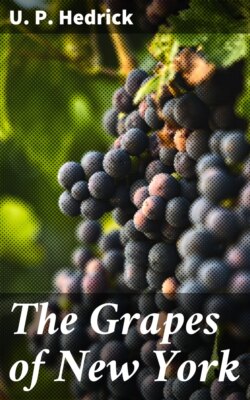Читать книгу The Grapes of New York - U. P. Hedrick - Страница 20
2. VITIS MUNSONIANA Simpson.
Оглавление1. (?) Rafinesque, 1830:17. V. peltata; V. Floridana. 2. Munson, Am. Pom. Soc. Rpt., 1885:97. V. floridana; Florida grape. 3. Ib., Gar. Mon., 28:140. 1886. V. floridana; V. peltata; Florida grape. 4. Ib., Soc. Prom. Ag. Sci. Rpt., 1887:59. Everbearing grape. 5. Ib., Gar. and For., 3:474, 475. 1890. 6. Ib., U. S. D. A. Pom. Bul., 3:14. 1890. 7. Ib., Mich. Hort. Soc. Rpt., 1893:116. Bird grape; Everbearing grape. 8. Ib., Bush. Cat., 1894:20. Bird grape; Mustang grape of Chapman. 9. Bailey, Gray’s Syn. Fl., 1:421. 1897. Mustang grape of Florida; Bird grape; Everbearing grape. 10. Munson, Tex. Sta. Bul., 56:232, 241. 1900. Florida Bird grape. 11. Viala and Ravaz, Am. Vines, 1903:42, 45.
Vine not very vigorous, a slender grower, usually running on the ground or over low bushes. Canes slightly angular; internodes short; tendrils intermittent, simple. Leaves smaller and thinner than Rotundifolia and rather more circular in outline; not lobed; teeth rather open and spreading; petiolar sinus V-shaped; both surfaces smooth, rather light green. Cluster with more berries but about the same size as Rotundifolia. Berry one-third to one-half the diameter, with thinner and more tender skin; black, shining; pulp less solid, more acid and without muskiness. Seeds about one-half the size of Rotundifolia, similar in other respects. Leafing, flowering, and ripening fruit very late.
In 1830 Rafinesque described, under the name Vitis peltata, or Vitis floridana, “a very singular species, lately found in Florida.” This description is brief and includes many characters of no taxonomic value. In 1885 or 1886, Mr. J.H. Simpson of Manatee, Florida, sent a specimen of a grape growing in his locality to Munson which was taken to be Rafinesque’s Vitis peltata. He consequently described it under the name Vitis floridana but the species was not generally accepted. Later Simpson gave it the name Vitis munsoniana.
Its habitat is central and southern Florida and the Florida Keys, and it is said to be the only grape growing on these Keys. It extends south of the habitat of Rotundifolia and blends into this species at their point of meeting.
Munsoniana appears to be a variation of Rotundifolia, fitted to subtropical conditions. It is tender, not enduring a lower temperature than zero. In the matter of multiplication it differs from Vitis rotundifolia in that it can be propagated readily from cuttings. Like Rotundifolia it is resistant to phylloxera. The species is of no value horticulturally.
